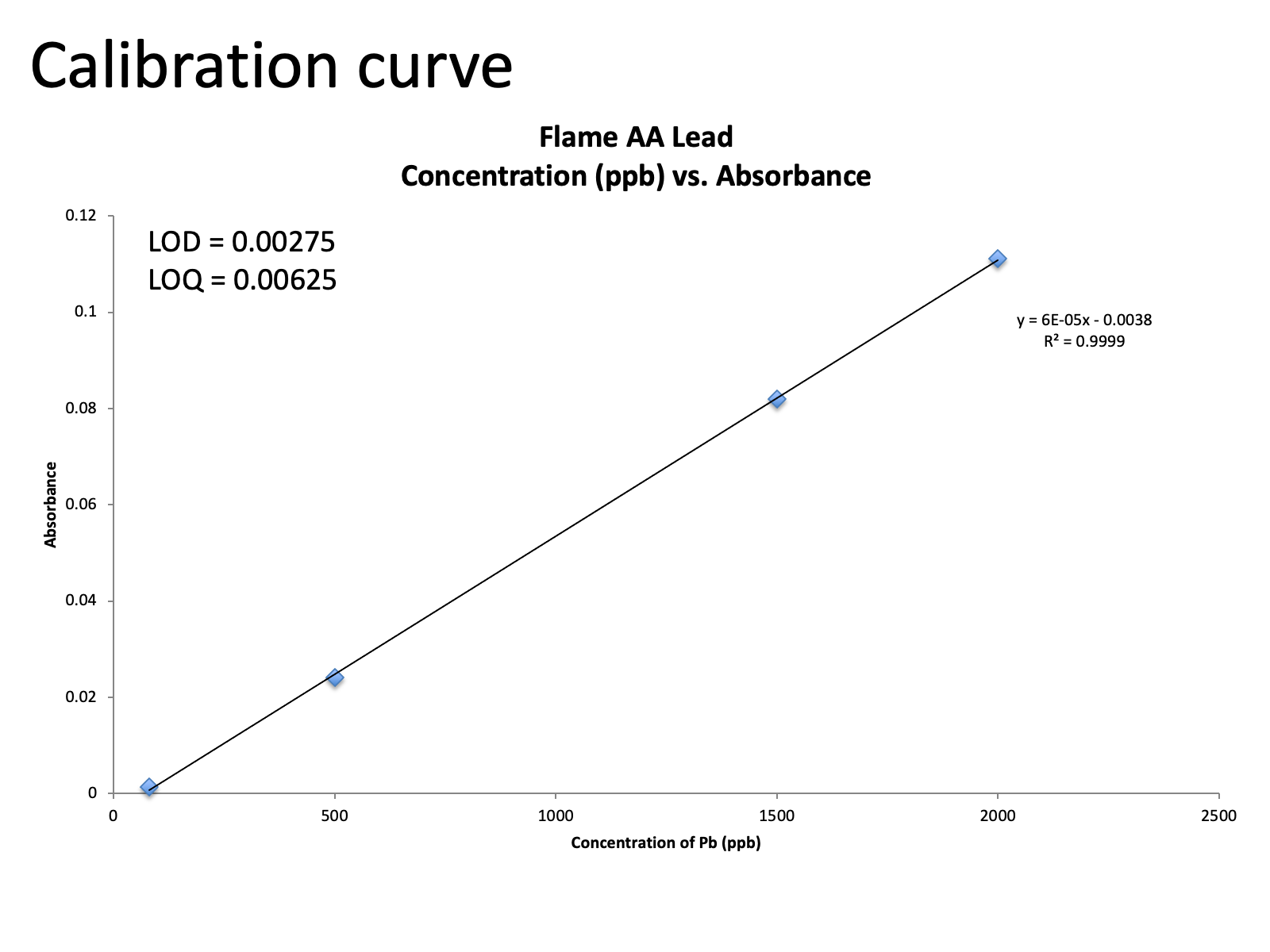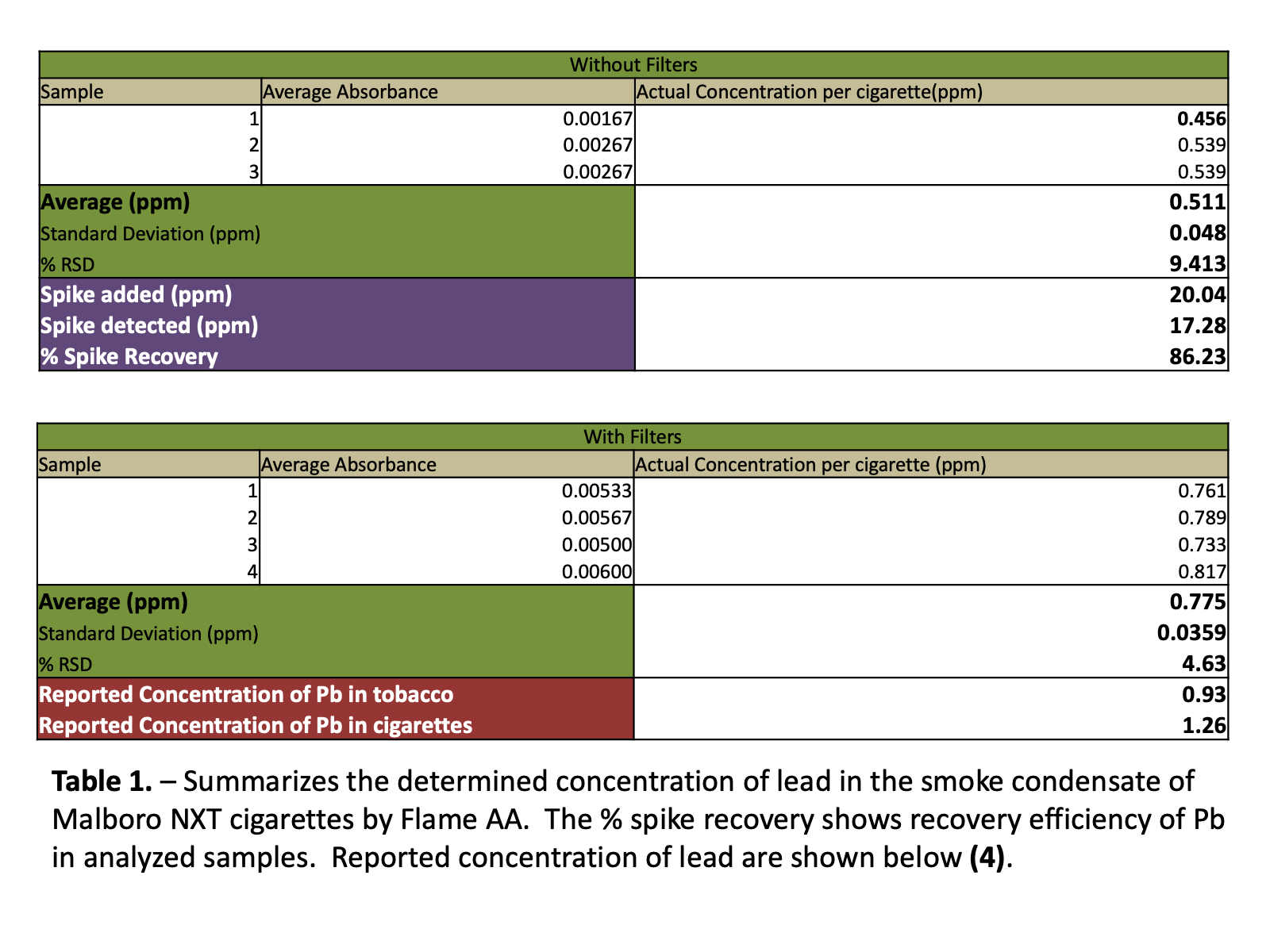Overview
This study evaluates the concentration of Pb in the smoke of Marlboro NXT cigarettes. Two groups (filtered and filter removed) of cigarette samples were analyzed by Flame Atomic Absorption Spectrometry (Flame AA). The total concentration of Pb in the smoke per cigarette ranged from 0.511 to 0.775 ppm. The statistical analysis determined that there is a significant difference among the studied groups at the 95% interval.
Introduction
Tobacco leaves trap both radioactive (Pb-210) from the atmosphere on their surface, due to the presence of trichomes (sticky hairs that trap particles and retain them after washing with water). This is believed to be the main source of lead in tobacco.
Around 11% of lead from cigarettes enters the smoke, and roughly half of that is believed to enter the lungs of smokers. The bulk of the remainder is found in the ash, though some contaminates the environment, increasing the lead levels of dust in the households of smokers.
Being insoluble, small quantities of Pb-210 are retained in lungs, releasing radiation as it decays to Polonium-210. The average 1 pack a day smoker is exposed to the equivalent of over ten times the average US background radiation exposure, roughly one third of this from Pb-210. (1)
Experimental Design
A simple smoking apparatus was constructed by employing a twenty four port solid phase-extraction system that yielded reproducible smoking conditions and allowed several cigarettes to be smoked simultaneously. (2)
Smoke of two types of cigarette samples was collected on the Membrane Acrodisc syringe filters. One of the eight collected samples was spiked with a known Pb stock solution and then all the replicates were digested in concentrated HNO3 acid using Mars Microwave. (3)
Standard curve of four lead solutions prepared from the Pb standard was created.
Diluted to 5% HNO3 samples were analyzed in triplicates using the Flame AA at the wavelength of 283 nm.
Results
Goals
The main objective of the project was to determine the effectiveness of cigarette filters on trapping heavy metals. By evaluating lead content in the smoke condensate of cigarettes in each group, we compare the effectiveness of the filter.
Illegal tobacco tends to have higher levels of heavy metals including lead, while lead has sometimes been added to tobacco to increase their weight. The concentration of Pbin the cigarette smoke of commercially available MarlboroNXT is compared to the finding of previous independent studies to evaluate the levels of lead in locally purchased cigarettes.



Statistical Analysis
A two sample t-test was conducted in the SPSS programming software resulting in the P(significant) being less than 0.001, thus indicating that the difference in concentrations of Pb in the smoke condensate of two groups was statistically significant at the 95% confidence interval.
Conclusions
The concentration of lead in the commercially available MarlboroNXT cigarettes was measured to be 0.511 +/- 0.048 and 0.775 +/- 0.0359 ppm for filter removed and filter present samplesrespectively. Both results turned out to be lower than the reported value of 1.26 ppm (4), which indicated that these particular cigarette samples were not deliberately falsified to achieve an increased weight of a cigarette. It is also worth mentioning that all three samples of filter present group turned out to be lower than the LOD.
Interestingly enough, the initial prediction about filters as a mean to trap the heavy metals on the path of inhaling the smoke was incorrect that was supported by the experimental data; however, leaving a room for an error in the process of a smoke collection itself. Moreover, two groups were determined to be different based on the conventional criteria of a two sample t-test conducted using SPSS programming software which resulted in the P value less than 0.05 significance level.
References
Taylor, R. “Tobacco and lead toxicity.” LEAD Group Inc. 2014.
Gonzalez-Ruiz, V., Martin, A., Olives, A. “An Easily Built Smoking Machine for Use by Undergraduate Students in the Determination of Total Particulate Matter and Nicotine in Tobacco Smoke.” J. Chem. Educ., 2012, 89 (6), pp. 771-775.
“Guidelines for Microwave Acid Digestion.” ETHOS D User Manual – Rev. 0/2001.
Lazarevic, K., Nikolic, D., Stosic, L. “Determination of Lead and Arsenic in Tobacco and Cigarettes: An Important Issue of Public Health.” Cent Eur J Public Health, 2012; 20 (1): 62-66.


